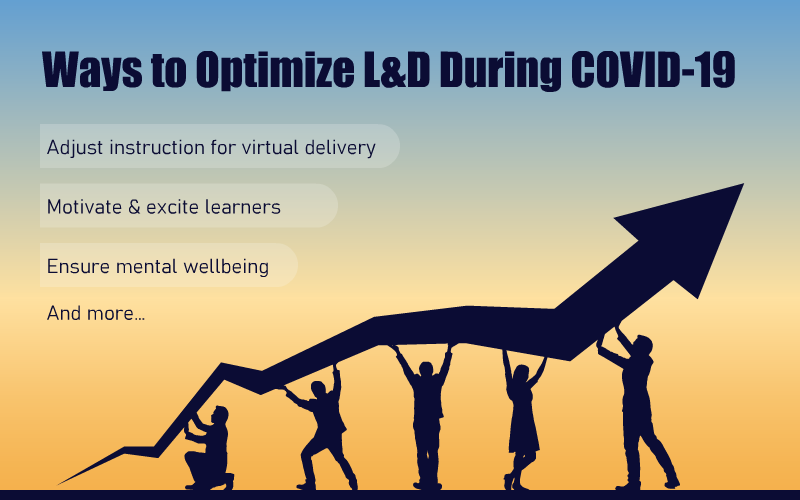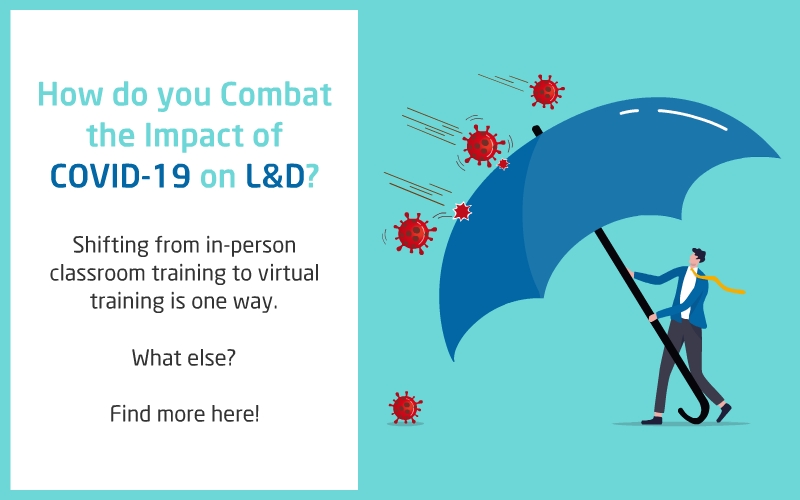Optimizing L&D During COVID-19: A 5-Point Formula for Success

COVID-19 is going to stay longer than we think. Citing the head of the World Health Organization (WHO), a report by Al Jazeera says, “there is a long way to go” since there were “worrying upwards trends” in parts of Africa and central and south America. As much as we would like the situation to revert to normalcy, it looks like we have to accept social distancing as the ‘new normal’. While businesses are reconfiguring their operations to combat the disruptions due to COVID-19, L&D leaders are trying to migrate in-person classroom training to virtual training.
This shift to virtual training is vital to future-proof workplace training, to make it resilient in the face of similar adversities in the future. Since many organizations are going digital for the first time, apprehensions are quite natural.
Explore our rapid response initiatives to help the L&D fraternity combat COVID-19’s impact.
However, here are 5 key considerations to take into account for the success of your virtual training strategy during the COVID-19 pandemic.
How do you Optimize L&D During the Time of COVID-19?
- Plan and adjust instruction for virtual delivery
- Ensure content is online-ready
- Generate motivation and excitement
- Offer opportunities for collaboration
- Consider the mental wellbeing of learners
5 Ways to Optimize L&D During COVID-19
1. Plan and Adjust Instruction for Virtual Delivery
It is important that the instruction in the virtual training is clear, logical, and well-organized – especially because your learners are new to online learning. You don’t want them to be confused during the training and let all the hard work go to waste.
In the classroom, the instructor monitors learners’ understanding and adjusts the session accordingly. Also, it is easier for the instructor to deliver information incrementally and offer feedback in real-time – keeping learners engaged in the learning process. However, in the virtual training environment, it is difficult to do that. There is a risk of losing learners’ interest if lessons are poorly organized or if learners are given too much information too soon. So, how can you reduce these risks in virtual training?
- Define performance-based learning objectives for every virtual training session. This tells learners the ‘what’s in it for me’ and helps them relate the learning to the workplace.
- Ensure the training is well-structured (for eLearning courses or VILT sessions) with topics flowing smoothly from one to another.
- Deliver training in manageable chunks. The aim should not be to cover as much as you can, lest you overburden your learners. Be it eLearning or VILT, try not to stretch the virtual training session beyond 60 minutes. Moreover, space out the sessions for better assimilation.
- Provide timely feedback. Feedback in formative assessments in eLearning shouldn’t just tell if the answer is right or wrong, it also needs to explain why it is so. You can use the chat and whiteboard features of your virtual platform to do the same for VILT sessions.
- Offer practice opportunities within virtual training sessions to enhance knowledge retention – simulations, scenarios, and game-based activities in eLearning courses; and allow learners to share their screens to demonstrate usage or share information in VILT.
2. Ensure Content is Online-Ready
Along with clear instruction comes the need for high quality content that is appropriate to the learners’ level of knowledge and skills. In the face to face classroom setting, the instructor has the opportunity to explain the content better (if learners fail to understand). In virtual training, this might not be so easy.
That said, you cannot simply convert your content from ILT to virtual training. There’s a lot of pre-work that goes in to ensure the content is appropriate for your online learners in virtual training.
Here’s how you can do that.
- Ensure existing ILT resources are complete and meet the set learning objectives.
- Take the help of your Subject Matter Experts (SMEs) to fill content gaps (if any) and ensure content is updated before going on the virtual medium.
- Simplify ILT content to make it easier to understand in the absence of the instructor.
- Ensure just the right, need-to-know content in each virtual training session.
- Use appropriate instructional methods for effective training delivery – eLearning simulations for hands-on software training, videos to explain or demonstrate a concept or process, and scenarios to hone decision-making skills.
3. Generate Motivation and Excitement
Training disruptions due COVID-19 have led to a sudden shift to virtual training, giving little or no time to learners to adjust to the new reality. So, you have to motivate and build excitement about the online training. This is crucial to create learner engagement during the virtual training, be it synchronous (VILT) or asynchronous (eLearning).
Here are some ways to ensure a ‘face to face’ feel and engagement in virtual training.
|
Ways to Motivate and Excite in Virtual Training |
|
| Before Training |
|
| During Training | VILT
eLearning
|
| After Training |
|
4. Offer Opportunities for Collaboration
Humans are social animals (something COVID-19 is capitalizing on!). Offering a chance for personal interaction is crucial for effective learning. In the classroom, one-on-one interactions help foster relationships with the instructor and peers. In a virtual environment, you can replicate the same through emails, work groups, the organization’s learning portal, or the new-gen alternative – social media.
Here are some ways you can offer collaboration using social media platforms:
- Create groups in sites such as Microsoft Teams, LinkedIn, Twitter, or even your organization’s learning portal to begin with. This gives learners an additional avenue for learning.
- Host discussions and Q&A sessions with the Instructor or Subject Matter Expert (SME) as the host. Encourage learners to clarify doubts that were not addressed in the formal training session.
- Create social media profiles of instructors or SMEs. Let learners get their queries clarified in the personal window. This works well for learners who are shy to ask questions in the session.
- Post learning resources on social media platforms frequently to encourage interactions.
5. Consider the Mental Wellbeing of your Learners
Good mental health is not only a vital outcome in itself; it is a means to other important outcomes – such as learning. If mental health suffers, learning usually suffers. The mandatory ‘work from home’ because of COVID-19 may fuel loneliness, isolation, and fear. Most organizations have put in place the basic tools to support, and communicate with their employees.
A quick rundown of what should now be in place:
- A cross-functional leadership team to evaluate and address the impact of the pandemic, from workplace and remote work adjustments to financial and healthcare questions
- A multi-channel communications system for collaboration with everyone in the organization – with video, instant messaging, and document sharing
- A quick-response team to help employees in case of any medical emergency during the lockdown – information on how to report, nearby hospitals, medical insurance, and so on
- Video-conferences or webinars to address employees’ concerns about business continuity and acknowledge employees’ contributions
- Credible articles, videos, and blog posts on symptoms and precautions to keep your employees informed
Virtual training offers tremendous opportunities for learning during times like these when it is difficult to attend in-person training. At the same time, poor quality online instruction can be a significant challenge to learning. The five considerations presented here provide a means for organizations to develop and deliver online learning to optimize their workplace training during COVID-19.
End Remarks
Virtual training is undoubtedly the need of the hour. But the question is – how do you create impactful virtual training? Here’s something that might help!
Discover how to make your virtual training as engaging and impactful as in-person classroom training in just 60 minutes! Explore our eLearning course now!





![Top 5 Convincing Reasons to Switch from Classroom Training to VILT [SlideShare]](https://blog.commlabindia.com/hubfs/Imported_Blog_Media/vilt-reasons-say-yes-classroom-training-slideshare.png)